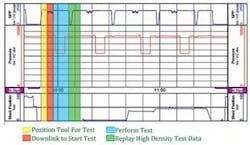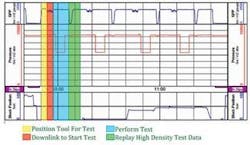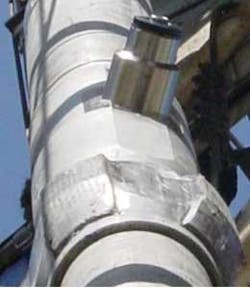Real-time formation pressure testing extends ‘while-drilling’ capabilities
Jim Wilson - Halliburton Sperry Drilling Services
The growing complexity of drilling applications makes real-time formation pressure data acquisition increasingly vital to successful reservoir development. In deepwater exploration wells, where one critical challenge is the ability to optimize mud weight and manage equivalent circulating density (ECD), the ability to obtain formation pressure while drilling (FPWD) data in real-time has proven valuable.
When used to guide exploration drilling in a recent Gulf of Mexico well, the GeoTap formation pressure tester from Halliburton Sperry Drilling Services successfully acquired real-time logging while drilling (LWD) formation pressure test data at record depths and record high formation pressures, to provide critical reservoir information that led to a revised completion strategy which saved the operator more than $6 million.
Real-time formation pressure testing saves time and money because faster testing require less rig time than wireline testing. It also increases safety through better well control.
Real-time data provides visual evidence of pressure changes as they occur. Such while-drilling data affords a clearer understanding of the reservoir, revealing current pressures and gradients, such as under-pressured “thief” zones. Real-time knowledge of formation pressures also allows continuously updated wellbore stability assessments to help optimize well length.
GeoTap sensor Pressure-While-Drilling (PWD) annular pressure data is transmitted continuously, so even during connections and tripping, accurate real-time information on swab and surge pressures is received and potential lost-circulation or influx situations can be recognized. Such precise pressure management also results in less invasion, which means less formation damage. In addition, with PWD data can be used for continuous monitoring of hole cleaning, further reducing formation damage due to swab/surge.
The most obvious benefit of formation pressure testing while drilling is an increase in drilling efficiency. Real-time data can be used to determine precise overbalance for maximizing rate of penetration (ROP), and also provides a means of geosteering, using the tool to measure absolute pressure gradients to determine the wellbore’s position relative to fluid contacts in the reservoir. This can be useful when the wellbore position uncertainties are greater than the actual geometrical dimensions of the reservoir.
Halliburton Sperry Drilling Services GeoTap formation pressure tester provides subsurface pressure measurements using downhole hydraulics and a single pad/probe design. With this service, formation mobility estimates can be made near the bit in real time, which provides critical information during drilling. Pressure tests, with pumps off or pumps on, are achieved in five or 10 minutes dependent on formation permeability. The tester replaces wireline or pipe-conveyed logging services, which are time intensive and represent higher operational risk.
Sperry Drilling Services has built tools in all normal LWD collar sizes for hole sizes from 5 7/8 to 18 in. In addition to reservoir pressure and mud density information, the PWD sensor in the tester measures annular and bore pressure while drilling.
PWD operation
Annular pressure increases often reflect ineffective cuttings removal and poor hole cleaning, either of which can lead to lost circulation. When the increase is detected in real time, drilling fluid parameters and operating procedures can be modified to improve hole cleaning. On extended reach wells, this real-time capability helps maintain wellbore pressures between safe operating limits, as well as helps monitor hole cleaning.
The PWD sensor also provides early detection of flows and kicks. In deepwater riserless drilling, an increase in annular pressure indicates the likelihood of a shallow water flow. A drop in pressure, on the other hand, can indicate gas, oil, and water kicks. Because the sensor takes downhole measurements, it is possible to detect such pressure drops earlier than with traditional surface measurements.
Pressure data can be transmitted in real time and recorded in downhole memory simultaneously. In the pumps-off mode, the minimum, maximum, and average pressures observed during the non-circulating period are transmitted via mud pulse telemetry when circulation recommences. These measurements provide the foresight to avoid lost circulation and detect flow/kicks before they happen.
Incorporating high accuracy quartz gauges, the battery-powered GeoTap tester can record all measured data, making it useful in specialized drilling environments such as high-pressure/high-temperature, extended-reach, and deepwater wells.
FPWD operation
In operation, the toolstring places the GeoTap tester in position. The tool can be configured to run tests with pumps on or off. With a command from surface via the Geo-Span downlink system, the test sequence starts and pressure recording begins.
When placed in the formation pressure test mode, the tester extends a wireline-type pad/probe assembly with up to 6,000 lb of force to seal against the borehole wall. The downlink system enables the tester to reconfigure testing parameters during the test while the pad is still on the testing zone with pumps on.
To further isolate the pressure test from pump noises, the snorkel then extends to penetrate the mud cake, and an internal piston is actuated to draw down the pressure inside the probe by as much as 5,000 psi (34.5 MPa) below hydrostatic pressure.
Once internal probe pressure builds to formation pressure, the probe/pad is released, and post-test hydrostatic pressure is measured. With the inside of the snorkel wiped clean, the tool is ready to drill ahead or perform another pressure test.
Visual interpretation of data quality at the time of the test helps determine actual formation pressure, and whether there is a need to repeat the test.
The introduction of wired pipe telemetry in combination with the GeoTap tester permits interaction with the sensor, with precision and data rates comparable to wireline, for complete analysis of memory quality data in real time. An ultra high-speed alternative to current mud pulse telemetry methods, the wired drill pipe system uses individually wired drill string components that can deliver bi-directional telemetry at speeds of 57,000 bits per second, connecting downhole tools and measurement nodes along the drill string, and greatly expanding the quantity and quality of information available while drilling.
Application in high-cost environment
The GeoTap sensor bridges a gap in drilling safety and optimization to provide early, reliable measurements of key reservoir properties. At a water depth of 4,986 ft (1,520 m) in a Gulf of Mexico deepwater well, the GeoTap formation pressure tester provided real-time pore pressure measurements of the formation to help optimize mud weight and manage ECD.
The drilling team utilized the 9 ½-in. and 8-in. size GeoTap tools to measure actual formation pressure as they drilled. The tester provided real-time formation pressure measurements. This aided in determining and maintaining optimal mud weight, which in turn reduced formation damage and increased rate of penetration.
Specifically, use of the 8-in formation pressure tester established several record performances in this well, including achieving the deepest-ever, high-quality test, taken at 29,898 ft (9,113 m) measured depth, 28,525 feet (8,694 m) TVD. In addition, the tool acquired two of the highest measured pressures to date, with a hydrostatic pressure measurement of 22,538 psi (155.4 MPa), and formation pressure of 22,008 psi (151.7 MPa).
The operator saved approximately $3 million when information provided by the GeoTap testers made it possible to eliminate a planned expandable casing string, and saved an additional estimated $3 million by eliminating the need for a contingent casing string. Based on this success, the tester now is part of the standard bottomhole assembly on subsalt deepwater exploration wells for this operator.
The future
FEWD technology is poised for even greater functionality, with pending introduction of the GeoTap IDS sampling and fluid identification while drilling tool. With this capability, multiple fluid samples are obtained within hours rather than days of drilling the formation. This will be the first time fluid samples have been recovered with LWD.
With drilling rig rates of $250,000 to $1 million per day, there is significant value in reducing the number of trips. GeoTap IDS sensor can eliminate the need for pipe-conveyed wireline sample tests and reduce extended pump-out times for clean samples with wireline.
A clean formation fluid sample is required for a thorough analysis. Studies show that the time required to obtain an uncontaminated fluid sample is a function of the formation exposure time, and increases significantly with longer exposure times. Since LWD is minutes or hours behind the drill bit, the formation contamination from drilling fluids is less.
Most significantly, more valuable data is more recovered in time for decisions to be made while drilling the reservoir. Providing valuable insight to the types of fluids encountered, such as water content, hydrocarbon type, and bubble point, this faster fluid sampling capability enables more timely solutions to be determined. In addition to optimizing completion strategies, such “advance information” can be used to help define the reservoir according to fluid recovered, which in turn can affect reserves estimates.
Positioned approximately 10 ft (3 m) from the LWD formation evaluation sensor, each sample collar contains up to five conventional 1-l wireline Reservoir Description Tool (RDT) system bottles, and can be stacked to carry 15 samples or more. Similar in operation to the formation pressure tester, the sensor is easily positioned for sample acquisition, and accommodates multiple samples from multiple zones.
Conclusion
Capitalizing on advances in while-drilling technology, new tools provide advanced formation evaluation measurements that create true “formation evaluation-while-drilling” capabilities to optimize wellbore placement for maximum production over the life of the reservoir. In high-cost environments such as deepwater exploration wells, this ability to deliver quality real-time data on reservoir characteristics can create time value and produce significant savings.
About the author
Jim Wilson is the principal global champion for Measurements/Logging-while drilling for Halliburton, Sperry Drilling Services. Wilson also serves as global product champion for the GeoTap formation pressure tester and LWD density neutron services with Sperry. He has more than 39 years of experience in the industry. He has coauthored papers on imaging and LWD applications. Wilson received his Bachelor of Science degree in physics from the University of Texas at Arlington. He is a member of SPWLA, SPE, and IADD.


